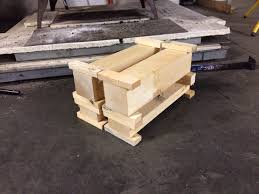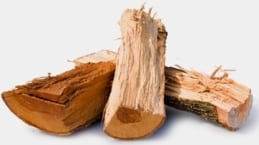Understanding Wood Boiler Efficiency

When it comes to wood boiler efficiency, too many are "high efficiency" boilers. How could practically all wood boilers be considered highly efficient? Is the term meaningless? Even informed buyers must find the landscape very confusing. One might think a government website could help solve the confusion. However, even the EPA site listing certified wood boilers does not make clear which products will be the most efficient in actual use. What is going on?
Firewood, the Natural Fuel, Is Difficult to Test
Wood and wood pellet boilers present unique challenges for establishing efficiency ratings primarily due to the unique nature of wood fuels. Firewood exists in various shapes, species, and moisture contents. Wood fuel changes states as it burns. It goes from a drying phase to a smoking phase, to a smoke ignition phase, to a charcoal burning phase. Each species of wood passes through these stages a little differently.
Further, wood fuels do not ignite or extinguish quickly. Even wood pellets, which are highly processed, can have various moisture contents, pellet fragment size, and fuel value. For example, pellets made with softwood, counterintuitively, have more energy value than pellets made with hardwood due to the resinous into the pellet.
To help compensate for the variability of firewood and resulting impacts on wood boiler efficiency during testing, most U.S. test methods limit allowable wood species. Due to wide geographic distribution, red or white oak test fuel is accepted throughout the U.S. to be compliant in Washington State, Douglas Fir must be used. Washington State firewood markets are dominated by pine, spruce, and fir.
Attempting to further reduce testing variability, until recently, all tests for firewood boilers required the wood to be cut into lumber with 4" x 4" cross sections. The length of each 4" x 4" fuel stick is determined by a formula based on the depth of the firebox. After being cut to length, the wood is nailed together with 3/4" spacers, forming a test “crib.” The crib of wood is basically a manufactured fuel pile nailed together with spacing in a neat, geometric pattern. Of course, that is not a realistic way to fire a wood boiler, so in addition to crib wood based testing, there are now at least two tests that allow natural firewood to be used.


Multiple Test Methods Create Maximum Confusion
Regardless of attempts to improve wood boiler efficiency, human operation of wood fueled boilers is always a factor. For example, frequent on/off cycling of a boiler run when in shoulder seasons or a boiler filled with green wood or garbage can create terrible smoke and low efficiency.
U.S. regulators responding to air pollution problems have become increasingly interested in the performance of wood fueled boilers operating in less-than-ideal, aka "average," scenarios. As a result, multiple test methods for wood fueled boilers now exist. The addition of new methods has had the unfortunate effect of allowing little comparability between boiler models tested with different methods.
There are two EPA-approved test methods for testing wood pellet boilers. Additionally, there are three EPA-approved methods for testing firewood boilers. One of those methods includes two annexes, effectively adding two other test methods. That makes a total of 5 firewood test methods.
The EPA also accepted European test results for some pellet boilers between 2015 and 2020. After 2020, European test methods were no longer recognized by the EPA. Much of Europe uses a single test method for firewood and wood pellet boilers, though increasingly, individual countries require small modifications to the standard.
EPA and "Hydronic Heaters" aka Wood Boilers
In 2015, driven by the states and EPA, the U.S. transitioned at the federal level from having zero mandatory testing to a requirement that all residential, wood fueled boilers be EPA certified to be legal for sale. Given the small pool of wood fueled residential boilers without any testing at all and the high cost of testing in 2015, regulators accepted many existing results from the various test methods, including the European test method.
After 2020, boilers formerly approved with European test results required re-testing. While the primary goal of new tests is to reduce emissions from wood boilers, wood boiler efficiency is also a target value.
Why was European testing accepted by the U.S. EPA and other U.S. regulators? Prior to 2015 and the advent of EPA certification, several states offered financial incentives for their citizens to install advanced wood fueled boilers. The incentives were created to encourage meeting renewable energy mandates and to help replace existing dirtier and less efficient technology.
A large percentage of advanced, wood fueled boilers eligible for incentives in 2015 were European. Due to the prevalence of European boilers, European test results were accepted prior to the EPA's involvement. New York State led the way by accepting European test results for their Renewable Heat New York program. Other states followed suit. European test data was converted to U.S. units of measurement in an attempt to provide units that correspond with typical U.S. test data.
The ability to convert test data from customary European units of measure to customary U.S. units doesn't result in true emission and efficiency comparisons. There is minimal harmonization between test methods. For instance, U.S. tests require wood fueled boilers to be tested at four different burn rates: <15% of nominal output, <25% of nominal output, <50% of nominal output, and 100% output.
Results of each test are then averaged using weighting, with 2/3 of weighting placed on the two lowest output tests, which is when boilers are typically operating most poorly. The nominal output test receives only 5% weighting. The weighting scheme demonstrates boiler operation in a typical scenario.
By contrast, Europeans test wood fueled boilers at nominal output and at 30% of nominal output. Both results are published. Think city and highway MPG ratings for vehicles. There is no weighting or averaging of results. Europeans have stated that operating a boiler at 30% of nominal output is the typical limit of good performance. Using the theory that wood fueled boilers should not be operated outside the limits of good performance, Europeans have not required testing with very low boiler output.
The Impact of Fuel Moisture Content on Calculating Efficiency Results
Further complicating test results, when it comes to efficiency, European efficiency is reported using the lower heating value (LHV) of wood fuel, whereas, in the United States, efficiency is reported based on the higher heating value (HHV) of wood fuel.
Here is a brief explanation of the difference between HHV and LHV and how heating values impact reported efficiency: When any fuel is burned, depending upon the moisture content and quantity of hydrogen in the fuel, there will be a release of water, typically in the form of steam, most of which is lost in the exhaust. The conversion of water to steam requires energy.
For the HHV of fuel, the energy "held" in the steam is accounted for and added to the fuel value. If the exhaust can be condensed and the heat in the steam recaptured, then HHV makes perfect sense. Stated slightly differently, HHV is a measure of all available energy in the fuel, assuming that heat in converted steam can be recaptured.
Using the LHV of a fuel does not account for energy used/lost to produce steam. Consequently, if boiler efficiency is based on the amount of energy put into the boiler versus the amount of energy output, using the HHV of a fuel will result in a lower efficiency rating.
In practice, that means boilerstested using the HHV of wood fuel, as we do in the United States, generally have substantially lower reported wood boiler efficiency than boilers tested in Europe purely as a result of how the efficiency rating is calculated. For example, a boiler tested in Europe with a 92% efficiency rating LHV will have an 82% efficiency HHV rating based on 25% moisture content fuel. As test fuel moisture content increases, the disparity between HHV and LHV efficiency increases. Those results will be very different even before the impacts of disparate burn rate categories mentioned above are added to the equation.
Remember that these two efficiency ratings are for the same boiler and do not change how much heat is converted from wood fuel to heat your house or how many emissions will be produced in everyday use.Given all of these factors, when reviewing wood boiler efficiency it is important to recognize the following:
- If wood boiler efficiency is reported at 99%, it is almost certainly combustion efficiency. 99% efficiency is likely not indicative of how much heat is being transferred from the fuel water for heating.
- There are multiple test methods. U.S. test methods will result in lower reported efficiency than European test methods.
- Using LHV or HHV for fuel will result in greatly different efficiency results. Europeans use LHV, and the U.S. uses HHV. A boiler tested with European methods will have higher efficiency results than the same boiler tested with U.S. test methods.
- The U.S. EPA list of certified hydronic heaters displays efficiency as seasonal average efficiency. Due to different test methods and testing, which is not necessarily indicative of how boilers are used in the real world, EPA efficiency listings are not useful.
- Wood boilers tested with actual firewood rather than crib wood should more authentically represent actual field use.
- Oil and gas boiler efficiency is somewhat comparable to EPA accepted wood fueled boiler efficiency ratings, but the comparison is far from perfect.
- Due to the more consistent nature of the wood pellet fuel and the near complete elimination of human operation, tested wood pellet boiler efficiency should more closely match actual field use than test results for firewood or wood chip fueled boilers. However, a new but still experimental test method called the "Integrated Duty Cycle test method, has resulted in dubiously low pellet boiler efficiency results.
- Because existing U.S. and European tests do not necessarily cause pellet boilers to cycle on and off during testing, efficiency may not match actual field use efficiency. Installations that limit on/off cycling and allow a pellet boiler to have long run times will generally yield higher boiler efficiency.
- From a policymaking standpoint, although firewood and wood chip boilers generally test less efficiently than wood pellet boilers, wood pellet fuels require at least 15% of their finished energy value to manufacture. That means that in many cases, considering the entire fuel production cycle beginning at the tree, firewood and wood chips are more efficiently converted to heat than wood pellets.
- Existing U.S. tests for wood fueled boilers can be somewhat accurate at predicting performance in the field, assuming the boilers are operated as required by the operator's manual.
- For firewood boilers, EPA restrictions on emissions are beginning to eliminate boilers that on/off cycle. The effect is that future boilers will likely have test results for efficiency that more closely match actual field performance.
The ongoing evolution of wood fueled boiler testing appears to have no finish line. With the Integrated Duty Cycle test method as one example, there are efforts in the U.S. to develop tests that will be indicative of wood fueled boiler performance during on/off cycling. Some agencies in Europe are also discussing tests more like American tests.
While it is helpful to have a single efficiency rating, such as the AFUE rating found on oil and gas boilers, when it comes to wood fueled boilers, it seems that U.S. consumers, policymakers, and regulators are likely to face multiple efficiency ratings and ample confusion for several years to come.
Comparing Wood Boiler Efficiency
Beyond various testing methods and standards, another factor influencing boiler efficiency is the type of boiler used. Different wood boilers have varying designs and intended uses, making their efficiencies different.
How Efficient Are Outdoor Wood Boilers?
Outdoor wood boilers typically have historically had a much cruder design than indoor boilers. In many cases, they consist of a steel firebox surrounded by water and covered with insulation and metal siding. Their design typically makes them less than ideal for combustion. They must also transfer heat through an underground pipe, which will lose heat as it travels through the ground. These factors lower the efficiency of typical outdoor wood boilers.
Outdoor wood boilers encourage the use of larger pieces of wood stored outside in freezing temperatures. Using large, frozen block of wood containing gallons of ice makes the wood harder to burn, so the boiler produces less energy and produces far more toxic pollutants. Newer EPA Certified outdoor wood boilers are far more efficient than older models but can still be less ideal for energy production.
How Efficient Are Indoor Wood Boilers?
Indoor wood boilers are carefully designed and insulated. They include advanced features like thermal storage, allowing for hot and fast fires. They also use smaller, drier pieces of wood, allowing a smaller portion of wood to yield more energy than the larger pieces of wood used in outdoor boilers.
Careful insulation keeps more of the heat from a wood boiler in the unit than the heat produced by an outdoor boiler. Even when heat escapes an indoor boiler, it stays in the home, unlike with an outdoor model where any heat that escapes is energy lost. These factors make indoor wood boilers more efficient than their outdoor counterparts.
Find an Energy-Efficient Indoor Boiler at Tarm Biomass
Navigating the complexities of energy efficiency ratings for boilers takes expertise. At Tarm Biomass, our knowledgeable team can discuss the various wood boiler options available and their efficiency. We provide high-efficiency wood boilers for heating your home. Reach out online to discuss our products and learn more about the energy efficiency of wood boilers.

With multiple brands of “small” wood chip boilers beginning to land on U.S. shores, how about a deep dive into how they’re testing out, as compared with the other well-established forms of wood fuel. The concept of feeding a burner with a slow but steady stream of fuel (chips) and the operator insuring moisture and chip sizing is within the OEM’s requirements should put chip-fed boilers north of cordwood boilers at least on the combustion efficiency side. As for the heat transfer efficiency there seems to be a lot more active heat exchanger cleaning be added to multiple brands, to help keep exchange efficiency up continuously, rather than when ever the operator gets around to doing it. I think its imperative for wood-burning appliance OEMs to keep pushing their designs, to help keep wood as a viable green alternative to fossil fuels. I grew up around a lot of dirty diesels and many other sources of fine particulates, in an agriculture setting, and now I get to read about the damage these pollutants do to young lungs. I have woodlot and want to heat with wood, but I refuse to be a pig and inflict harm upon my neighbors.
Hello Allen,
Tarm Biomass and Froling Austria currently import only larger chip burning boilers than what EPA residential test methods will handle. The largest Froling boilers sold in North America are below the required testing threshold for most jurisdictions. It is clear that in European markets, chip boilers are more efficient and cleaner burning than wood boilers. A model that is working well is the use of dry chips. The chips are actively dried and screened at a processor. Dry chips can be burned cleanly in smaller boilers and the fuel can be stored outside with low risk of freezing clumps. Of course active drying and screening adds cost compared to green chips. Different types of wood fuels suit different sized systems and allowable space for installations.
With multiple brands of “small” wood chip boilers beginning to land on U.S. shores, how about a deep dive into how they’re testing out, as compared with the other well-established forms of wood fuel. The concept of feeding a burner with a slow but steady stream of fuel (chips) and the operator insuring moisture and chip sizing is within the OEM’s requirements should put chip-fed boilers north of cordwood boilers at least on the combustion efficiency side. As for the heat transfer efficiency there seems to be a lot more active heat exchanger cleaning be added to multiple brands, to help keep exchange efficiency up continuously, rather than when ever the operator gets around to doing it. I think its imperative for wood-burning appliance OEMs to keep pushing their designs, to help keep wood as a viable green alternative to fossil fuels. I grew up around a lot of dirty diesels and many other sources of fine particulates, in an agriculture setting, and now I get to read about the damage these pollutants do to young lungs. I have woodlot and want to heat with wood, but I refuse to be a pig and inflict harm upon my neighbors.
Hello Allen,
Tarm Biomass and Froling Austria currently import only larger chip burning boilers than what EPA residential test methods will handle. The largest Froling boilers sold in North America are below the required testing threshold for most jurisdictions. It is clear that in European markets, chip boilers are more efficient and cleaner burning than wood boilers. A model that is working well is the use of dry chips. The chips are actively dried and screened at a processor. Dry chips can be burned cleanly in smaller boilers and the fuel can be stored outside with low risk of freezing clumps. Of course active drying and screening adds cost compared to green chips. Different types of wood fuels suit different sized systems and allowable space for installations.